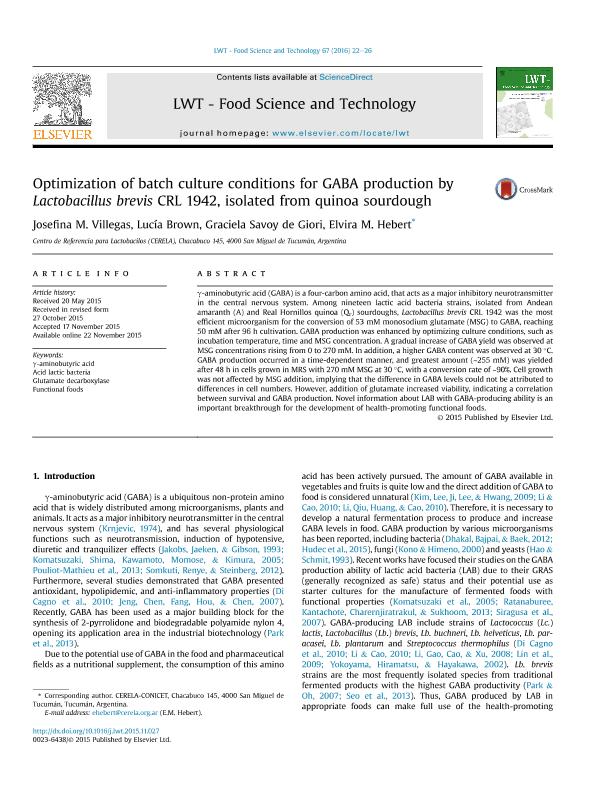Artículo
Optimization of batch culture conditions for GABA production by Lactobacillus brevis CRL 1942, isolated from quinoa sourdough
Fecha de publicación:
04/2016
Editorial:
Elsevier
Revista:
Lwt - Food Science And Technology
ISSN:
0023-6438
Idioma:
Inglés
Tipo de recurso:
Artículo publicado
Clasificación temática:
Resumen
ƴ-aminobutyric acid (GABA) is a four-carbon amino acid, that acts as a major inhibitory neurotransmitter in the central nervous system. Among nineteen lactic acid bacteria strains, isolated from Andean amaranth (A) and Real Hornillos quinoa (Qr) sourdoughs, Lactobacillus brevis CRL 1942 was the most efficient microorganism for the conversion of 53 mM monosodium glutamate (MSG) to GABA, reaching 50 mM after 96 h cultivation. GABA production was enhanced by optimizing culture conditions, such as incubation temperature, time and MSG concentration. A gradual increase of GABA yield was observed at MSG concentrations rising from 0 to 270 mM. In addition, a higher GABA content was observed at 30ºC. GABA production occurred in a time-dependent manner, and greatest amount (about 255 mM) was yielded after 48 h in cells grown in MRS with 270 mM MSG at 30 ºC, with a conversion rate of about 90%. Cell growth was not affected by MSG addition, implying that the difference in GABA levels could not be attributed to differences in cell numbers. However, addition of glutamate increased viability, indicating a correlation between survival and GABA production. Novel information about LAB with GABA-producing ability is an important breakthrough for the development of health-promoting functional foods.
Archivos asociados
Licencia
Identificadores
Colecciones
Articulos(CERELA)
Articulos de CENTRO DE REFERENCIA PARA LACTOBACILOS (I)
Articulos de CENTRO DE REFERENCIA PARA LACTOBACILOS (I)
Citación
Villegas, Josefina Maria; Brown, Lucia; Savoy, Graciela; Hebert, Elvira Maria; Optimization of batch culture conditions for GABA production by Lactobacillus brevis CRL 1942, isolated from quinoa sourdough; Elsevier; Lwt - Food Science And Technology; 67; 4-2016; 22-26
Compartir
Altmétricas




